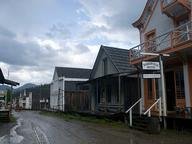
Tales of Gold 4 Trivia Quiz
"Gold! Gold! Gold! Gold! Bright and yellow, Hard and cold..."--Thomas Hood--It seemed like the potential for gold mining was endless in 1800s North America. See if you can give the modern name for the location of the mine by following the clues given.
A multiple-choice quiz
by ponycargirl.
Estimated time: 2 mins.
- Home
- »
- Quizzes
- »
- History Trivia
- »
- U.S. History
- »
- Gold Rush